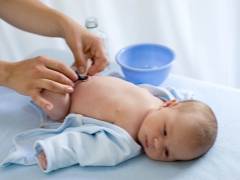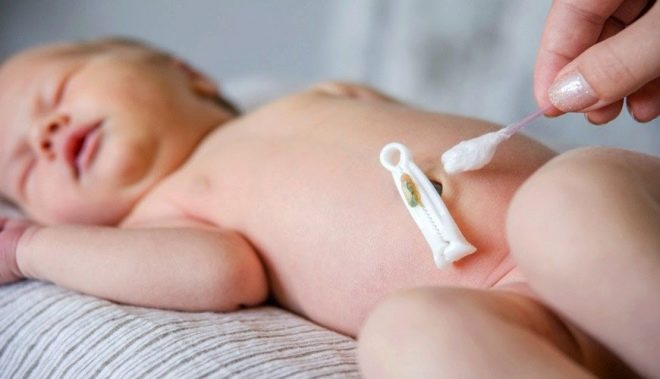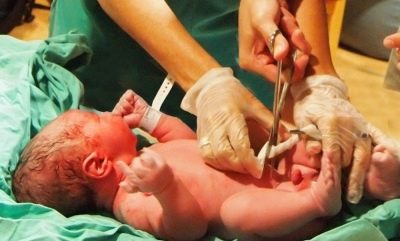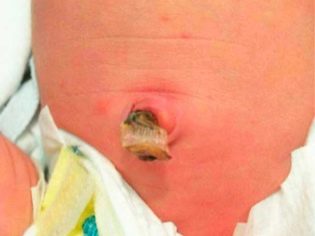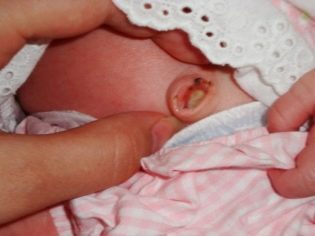On what day does the umbilical cord of a newborn usually drop off and what does it depend on?
The baby during its prenatal life is “connected” with the mother through a special “bridge” - the umbilical cord. After the baby is born, this connection is terminated. This article will tell you about which day the umbilical cord of a newborn usually drops out and what it depends on.
Special features
During his prenatal life, the baby is unable to feed on its own. It receives all substances necessary for its growth and development in a dissolved form. They enter through the umbilical blood vessels that are located in the umbilical cord. Also, the oxygen that is necessary for cellular respiration enters the children's organism through them.
The umbilical cord remains in the body of a pregnant woman until the birth. After the birth of a child, the umbilical cord is “born”. Next, an obstetrician-gynecologist cuts the umbilical cord, thereby "separating" the baby from her mother. Now the baby will breathe on its own.
Before cutting the umbilical cord, the doctor places special terminals on it. This is necessary in order for the umbilical vessels to stop their pulsation. This is a kind of "signal" for the internal organs of the baby, so that they begin their full work. After the pulsation of the umbilical vessels stops, the obstetrician-gynecologist cuts the umbilical cord.
Obstetricians use different methods for further processing of the umbilical cord stump. The first is that a special clip ("clothespin") without a fixing bandage is applied to the umbilical cord. Next, the stump is processed using hydrogen peroxide, potassium permanganate or brilliant green. This treatment contributes to the fact that the stump of the umbilical cord dries out and heals. Also, thanks to this method, the probability of wound infection is reduced.
Doctors recommend treating the umbilical cord before feeding the baby. In this case, he will transfer the procedure much calmer. When processing the umbilical cord stump, parents do not need to worry. During the procedure, it should be remembered that it is very important for the baby. Treat the wound should be very carefully, all movements should be smooth.
If the baby is discharged from the hospital with a clothespin on the umbilical cord, then it should be processed. Microbes can also accumulate on the clothespin, which can lead to suppuration of the umbilical wound. Handle clothespin should be carefully.
When the umbilical cord is clamped with a clothespin, the remaining fragment of the umbilical cord on the body of the baby disappears, as a rule, within 4-6 days.
This treatment has a number of drawbacks. So, after giving birth and until the wound heals completely, the mother should carefully watch how the baby's navel looks and how it heals.
Hygiene rules are very important. It is important to remember that the healing stump of the umbilical cord is a wound surface that can fester. In order to prevent infection, mother should remember that she should always take the child only with clean hands.
There is another way to handle the umbilical cord stump. In this case, the doctors remove the umbilical cord remains on the second day after the birth of the child. In this case, they impose a special compression bandage on the stump.
In the very first hours, a tight bandage is applied so that it squeezes the cut stump of the umbilical cord quite strongly. Subsequently, the pressure gradually decreases. After 24 hours, as a rule, such a bandage is removed.After that, the wound requires careful care with the use of hydrogen peroxide. In this case, the wound is usually delayed a week after delivery.
What affects healing?
The duration of the healing of the umbilical wound depends on many factors. It often happens that a woman who has just become a mother begins to worry that her baby has a navel that heals too slowly. Usually, the preceding conversation with a friend, in whom the baby’s umbilical cord had healed a little earlier, leads to the appearance of this thought.
Every child is unique from the moment of birth. The healing of tissues is an individual process and depends on a huge number of factors. Thus, the weight and state of the child’s immunity can even affect the healing rate of the umbilical wound. In a premature baby with a low birth weight, the navel can heal much longer than that of a full-term baby.
The correct care can have a positive effect on the healing period of the umbilical wound. So, in order for the umbilical cord stump on the navel to heal faster, doctors recommend not too tight to swaddle the child.
The ingress of water to the umbilical cord stump with a clothespin can help the wound heal somewhat longer. That is why for drying and processing of the wound drying agents are chosen.
The “sticking point” when leaving is often a clothespin superimposed on the umbilical cord. Reviews of many mummies indicate that it was she who caused them the real horror when processing the stump of the umbilical cord. Many women are beginning to worry that the clothespin can break and something terrible and irreparable will happen. Worry about this is not worth it.
Doctors note that with proper hygienic care, the clothespin left on the umbilical cord stump will disappear on its own. But the time that this will take may be different. For some, it persists for a couple of days, and for someone it does not disappear in a week. In this case, it is not the time for finding the clothespin on the umbilical cord stump, but careful hygienic care. With proper processing of the umbilical wound and the pin itself, the risk of infection of the navel in the newborn is minimal.
What does the baby's navel look like?
The appearance of the umbilical cord in the first days after birth can truly scare young and still inexperienced parents. The navel of a newborn baby is normal in the very first hours after birth, it has not yet completely formed. It represents only a wound surface with a cut off stump of the umbilical cord. However, this is only a temporary phenomenon. Already, as a rule, in a week the remains of the umbilical cord will disappear, and the baby's navel will look much better.
Another symptom that can alert and frighten young parents is the appearance of a small bleeding from the umbilical cord stump. This situation can also be. A sufficient amount of time must pass to heal the navel. In some babies, tissue heals slowly, so it takes longer to heal.
Mechanical injury to the navel may be accompanied by the development of minor bleeding. Young parents in the first days after the birth of their long-awaited baby are so much worried and worried that they will do something wrong, which by their actions can contribute to damage to the umbilical wound. Thus, droplets of blood on the stump of the umbilical cord of a baby may appear when carelessly putting on diapers or careless hygienic skin care of a newborn baby.
Care for a newborn baby should be carried out very carefully and carefully. The skin of the baby is very gentle and easily injured, so all the actions performed in relation to him should be very careful.
When a small amount of blood appears in the umbilical wound in the first days after birth, no treatment is required. This symptom will pass independently and without medical intervention.
If the parents find that the child has pus in the area of the navel, then in this case it is necessary to urgently show the baby to the pediatrician. In this situation, it requires the appointment of special medicines of local action, which have an antibacterial and wound-healing effect.
For information on how to handle the umbilical cord of a newborn, see the following video.
